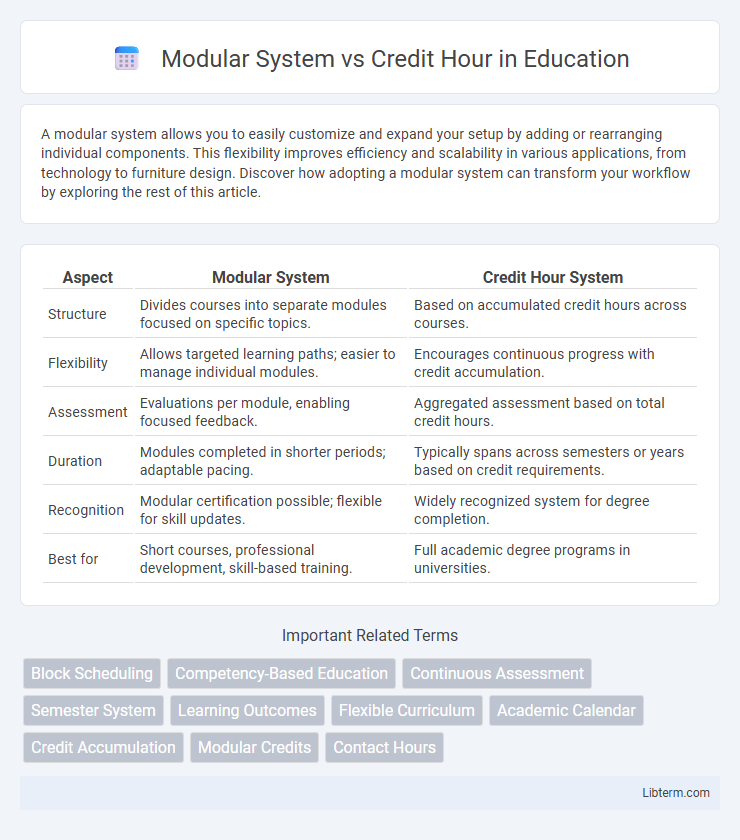A modular system allows you to easily customize and expand your setup by adding or rearranging individual components. This flexibility improves efficiency and scalability in various applications, from technology to furniture design. Discover how adopting a modular system can transform your workflow by exploring the rest of this article.
Table of Comparison
| Aspect | Modular System | Credit Hour System |
|---|---|---|
| Structure | Divides courses into separate modules focused on specific topics. | Based on accumulated credit hours across courses. |
| Flexibility | Allows targeted learning paths; easier to manage individual modules. | Encourages continuous progress with credit accumulation. |
| Assessment | Evaluations per module, enabling focused feedback. | Aggregated assessment based on total credit hours. |
| Duration | Modules completed in shorter periods; adaptable pacing. | Typically spans across semesters or years based on credit requirements. |
| Recognition | Modular certification possible; flexible for skill updates. | Widely recognized system for degree completion. |
| Best for | Short courses, professional development, skill-based training. | Full academic degree programs in universities. |
Overview of Modular System and Credit Hour
The Modular System divides academic content into distinct, standalone units, allowing students to focus intensively on one subject per module for a set duration, typically a few weeks. Credit Hour measures educational workload based on the time spent in lectures, tutorials, and study outside classroom hours, with one credit hour representing approximately one hour of teaching per week across a semester. The Modular System emphasizes depth in concentrated learning blocks, while Credit Hour focuses on cumulative instructional time spread over a longer period.
Key Differences Between Modular System and Credit Hour
The Modular System divides the academic year into distinct units or modules, each with specific learning objectives and assessments, allowing for focused and intensive study periods. In contrast, the Credit Hour system quantifies coursework based on the number of classroom hours per week over a semester, emphasizing cumulative time spent rather than discrete content blocks. Key differences include the Modular System's flexibility and shorter assessment cycles versus the Credit Hour system's focus on continuous attendance and time-based credit accumulation.
Structure and Flexibility in Learning
The modular system divides the curriculum into distinct, short-term units, allowing students to focus intensively on specific topics, enhancing concentrated learning and timely assessment. In contrast, the credit hour system measures academic progress through cumulative hours spent in class, offering a more traditional, semester-based structure with less frequent evaluation. Modular systems provide greater flexibility in pacing and course selection, accommodating varied learning speeds and enabling customized educational paths, while credit hours maintain a consistent rhythm but may limit adaptability for diverse student needs.
Impact on Student Progress and Graduation
Modular systems allow students to complete focused course segments in shorter time frames, often accelerating learning and enabling quicker accumulation of credits compared to traditional credit hour systems. Credit hour models emphasize semester-based progression where students accumulate credits over fixed periods, potentially leading to longer time to graduation if course loads are inconsistent. The modular approach enhances flexibility and adaptability, which positively impacts student progress by reducing time-to-degree and improving graduation rates through tailored pacing.
Assessment and Evaluation Methods
Modular systems assess student learning through frequent, focused evaluations such as quizzes, module tests, and practical assignments, enabling continuous performance monitoring and immediate feedback. Credit hour systems typically use summative assessments like midterms and final exams to evaluate cumulative knowledge over extended periods, emphasizing comprehensive understanding. Both methods incorporate formative and summative assessments but differ in pacing and frequency, impacting timely identification of learning gaps and instructional adjustments.
Adaptability to Diverse Learning Styles
Modular systems offer superior adaptability to diverse learning styles by enabling customized pacing and focused topic engagement, contrasting with the rigid structure of credit hour models. This flexibility supports visual, auditory, and kinesthetic learners through varied content delivery and assessment methods within each module. Consequently, modular approaches facilitate personalized education, enhancing comprehension and retention across heterogeneous student populations.
Institutional Implementation and Administration
Institutions adopting Modular Systems benefit from increased scheduling flexibility and streamlined course management, allowing for accelerated or customized learning pathways tailored to diverse student needs. Credit Hour frameworks require robust tracking and administrative oversight to maintain compliance with accreditation standards and federal financial aid regulations, often involving complex reporting mechanisms. Effective implementation of either system demands investment in administrative software capable of handling curriculum mapping, student progress monitoring, and resource allocation to optimize institutional efficiency.
Global Trends in Academic Frameworks
Global trends in academic frameworks show a growing shift towards modular systems, offering flexibility and personalized learning pathways compared to traditional credit hour models. Modular systems enable learners to accumulate competencies through discrete units, facilitating lifelong learning and international credit transferability. Institutions worldwide adopt modular frameworks to enhance curriculum adaptability, aligning education with rapidly evolving job market demands.
Pros and Cons: Modular System vs Credit Hour
The Modular System offers flexibility by allowing students to focus intensively on fewer subjects at a time, enhancing depth of learning and faster course completion, though it may lead to fragmented knowledge and scheduling challenges. The Credit Hour system provides a structured and consistent pace with a clear accumulation of credits toward a degree, promoting comprehensive coverage and ease of transfer, yet can result in slower progress and less adaptive learning experiences. Each system's effectiveness depends on institutional goals, student learning styles, and curriculum design.
Choosing the Right System: Factors to Consider
When choosing between a modular system and credit hour system, consider program flexibility, learning pace, and assessment methods. The modular system offers focused, competency-based learning segments ideal for skill acquisition, while credit hour systems provide cumulative credit accumulation suited for broad academic progression. Evaluate institutional accreditation standards, student workload management, and industry relevance to determine the optimal system for academic and career goals.
Modular System Infographic

 libterm.com
libterm.com